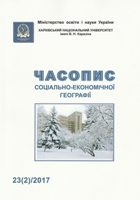Внутрішні протиріччя заповідної справи
Ключові слова:
природно-заповідний фонд, заповідні території, охорона природи, екологія, рекреація, туризм
Анотація
У статті розглянуто історичні фактори виникнення конфлікту між охоронною і рекреаційною функціями природоохоронної діяльності у світовій та вітчизняній практиці заповідної справи. Окреслено умови, що вплинули на особливості розвитку конфлікту: економічні, політичні, історичні. Визначено сучасний стан і тенденції в протистоянні двох важливих функцій заповідних територій та можливі шляхи вирішення даних протиріч з урахуванням об’єктивних та суб’єктивних чинників.
Завантаження
##plugins.generic.usageStats.noStats##
Посилання
1. Boreyko, V.E. (2010). Istoriya okhrany dikoy prirodyi v SShA [History of wildlife conservation in the USA]. Boreyko V. Istoriya ohranyi dikoy prirodyi v SShA.fb2.
2. Boreyko, V.E. (2000). Kritika osnovnykh podkhodov v sovremennom zapovednom dele [Criticism of main ap-proaches in modern nature reserve business]. Zapovidna sprava v Ukrayini. Kaniv: Kanivskyi pryrodnyi zapovid-nyk, 6(1-2), 1-2.
3. Zabelina, N.M. (1987). Natsionalnyi park [National park]. M.: Mysl, 170.
4. Zakon Ukrainy «Pro prirodno-zapovidnyi fond Ukrainy» (1992). [The Law of Ukraine "On Natural Reserve Fund of Ukraine"].
5. Eagles, P., McCool, S., Haynes, Ch. (2006). Ustoychivyi turizm na okhranyaemykh prirodnykh territoriyakh. Rukovodstvo po planirovaniyu i upravleniyu [Sustainable Tourism in Protected Areas Guidelines for Planning and Management]. M., 187.
6. Reymers, N.F., Shtilmark, F.R. (1978). Osobo okhranyaemye prirodnyie territorii [Protected areas]. M.: Progres, 298.
7. Svitlichna, O.V. (2015). Mozhlyvosti vprovadzhennya ekzotychnykh vydiv rekreatsii na terytorii obyektiv pry-rodno-zapovidnoho fondu Chernigivshchyny [The possibilityof introducing exotic recreation in the territory of the natural reserve fund of Chernihiv region]. Istoryko-arkheologichniy ta pryrodno-ekologichnyi potentsial Mezyn-skoyi okrugy: mynule, suchasne ta perspektyvy rozbudovy. Chernihiv: Desna Poligraf, 168.
8. Castley, J.G. An international perspective on tourism in national parks and protected areas. Available at: http://www98.griffith.edu.au/dspace/bitstream/handle/10072/53865/83543_1.pdf
2. Boreyko, V.E. (2000). Kritika osnovnykh podkhodov v sovremennom zapovednom dele [Criticism of main ap-proaches in modern nature reserve business]. Zapovidna sprava v Ukrayini. Kaniv: Kanivskyi pryrodnyi zapovid-nyk, 6(1-2), 1-2.
3. Zabelina, N.M. (1987). Natsionalnyi park [National park]. M.: Mysl, 170.
4. Zakon Ukrainy «Pro prirodno-zapovidnyi fond Ukrainy» (1992). [The Law of Ukraine "On Natural Reserve Fund of Ukraine"].
5. Eagles, P., McCool, S., Haynes, Ch. (2006). Ustoychivyi turizm na okhranyaemykh prirodnykh territoriyakh. Rukovodstvo po planirovaniyu i upravleniyu [Sustainable Tourism in Protected Areas Guidelines for Planning and Management]. M., 187.
6. Reymers, N.F., Shtilmark, F.R. (1978). Osobo okhranyaemye prirodnyie territorii [Protected areas]. M.: Progres, 298.
7. Svitlichna, O.V. (2015). Mozhlyvosti vprovadzhennya ekzotychnykh vydiv rekreatsii na terytorii obyektiv pry-rodno-zapovidnoho fondu Chernigivshchyny [The possibilityof introducing exotic recreation in the territory of the natural reserve fund of Chernihiv region]. Istoryko-arkheologichniy ta pryrodno-ekologichnyi potentsial Mezyn-skoyi okrugy: mynule, suchasne ta perspektyvy rozbudovy. Chernihiv: Desna Poligraf, 168.
8. Castley, J.G. An international perspective on tourism in national parks and protected areas. Available at: http://www98.griffith.edu.au/dspace/bitstream/handle/10072/53865/83543_1.pdf
Опубліковано
2017-11-30
Цитовано
Як цитувати
Світлична, О. (2017). Внутрішні протиріччя заповідної справи. Часопис соціально-економічної географії, 23(2), 124-127. https://doi.org/10.26565/2076-1333-2017-23-18
Розділ
Дослідження молодих науковців
Авторське право (c) 2017 Олександра Світлична

Цю роботу ліцензовано за Міжнародня ліцензія Creative Commons Attribution 4.0.




